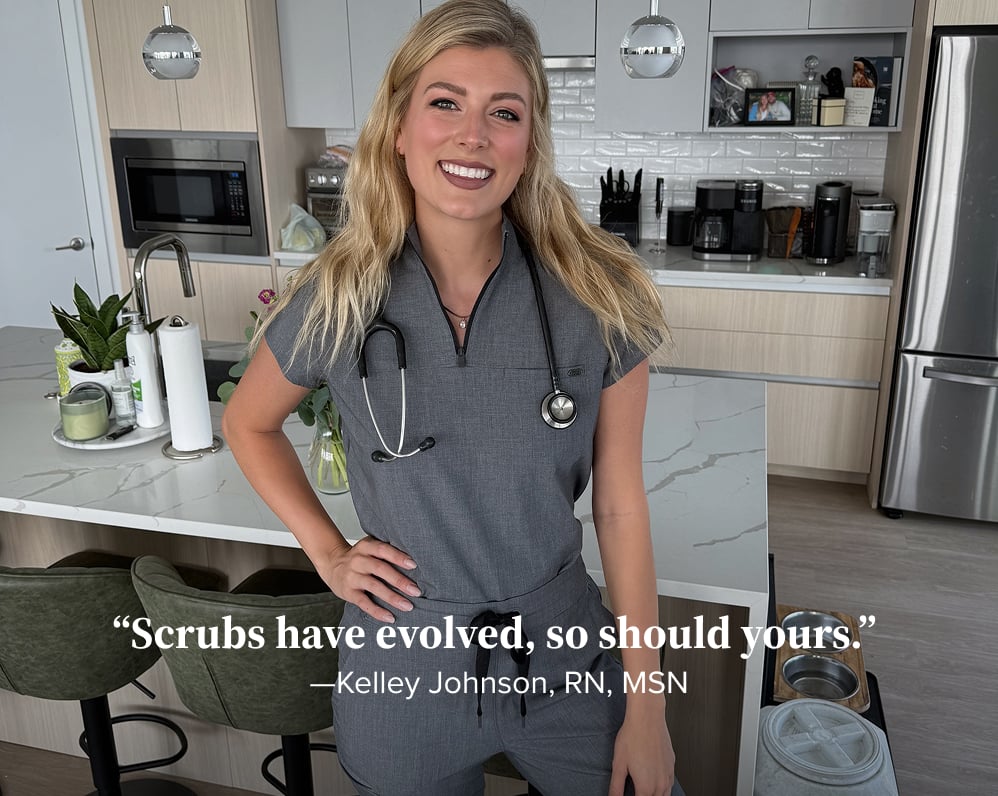
Hello, healthcare friends! My name is Kelley Johnson, and I am the national spokeswoman for Healing Hands. I have been with the company for a decade, thoroughly enjoying the ride through scrub history. Let’s be honest, when most people think about “medical fashion,” they don’t exactly picture a runway. (I did wear Cherokee Uniforms on the Miss America stage, but that’s a story for another time). That being said, just ask any nurse, doctor or tech today, and they’ll tell you: scrubs are a vibe. Whether you’re team jogger-pants or rocking a cartoon-print top in pediatrics, today’s scrubs are as much about function as they are about expression.
However, scrubs weren’t always the stylish, color-coded uniforms we know today. In fact, their journey from bloody aprons to breathable athleisure wear is a wild ride complete with scientific breakthroughs, WWII influence and even a fashion brand empire that changed the game. Let’s scrub in and dive into the surprisingly cool history of medical attire.
Before Scrubs: Healthcare Fashion Was… Questionable
Back in the 1800s, doctors were out here performing surgery in suits. Yes, actual street clothes. Picture a guy in a vest and tie elbow-deep in an open wound. Cute? Not exactly. Sanitary? Definitely not.
White coats were introduced in the late 19th century to project cleanliness and professionalism, but they weren’t doing much in the way of preventing infection. Nurses wore stiff dresses, aprons and caps that looked more like something out of a Victorian boarding school than a hospital. It wasn’t until the early 20th century that hygiene really started to matter in medicine. Surgeons began realizing that, hey, maybe wearing the same pants you wore to brunch isn’t the best idea when you’re cracking open a ribcage. Revolutionary.
Scrubs Get Their Scrub On: 1940s–1970s
By the time World War II rolled around, the concept of sterile surgery was finally catching on. Surgeons began wearing cotton gowns, gloves and caps in the OR to reduce infection risk. White was the original color of choice—because “clean”—but turns out staring at bright lights and even brighter white clothes made surgeons feel like they were going snow-blind mid-surgery. So hospitals pivoted to calming blues and greens. Aesthetic and functional.
By the 1960s and ‘70s, hospitals began dressing more of their staff in standardized, practical two-piece outfits: short-sleeved tops and drawstring pants made of cotton or poly blends. These became known as “scrubs,” thanks to the practice of “scrubbing in” before surgery.
Scrubs were practical. They were cheap. They were... extremely boxy. But they were a step in the right direction.
Enter the Game Changer: Healing Hands Scrubs
Fast forward to 2008, when Healing Hands entered the chat — and everything changed.
But the story actually starts back in 1997. That’s when Bansi, the founder of Healing Hands, suffered a massive heart attack at just 43 years old. It was the nurses—the calm in the chaos—who helped save his life. He never forgot it. In fact, he made a promise right then: to give back to the “angels” who got him through it. And give back he did.
Bansi looked around at the sea of scratchy, shapeless uniforms and said, “Yeah, no. We can do better.” And better they did: Healing Hands brought real fashion to the scrub world, introducing new fits and quality materials that actually felt good to wear on a 12-hour shift.
If you’ve ever worn Healing Hands scrubs for women and men, you know what I mean. These weren’t just uniforms anymore — they were comfortable, cute and a way for healthcare workers to express themselves in a world that’s often anything but glamorous.
Healing Hands became part of Careismatic Brands, the largest medical apparel company in the world, setting trends, launching stretch fabrics before it was cool and proving that even in sterile environments, style matters. They made it possible to walk into work in jogger scrubs and still feel like a boss.
Scrubs in the 2000s and Beyond: Identity, Comfort, and TikTok Fame
As scrubs became more colorful, fitted and functional, healthcare professionals started using them to make a statement. Pediatric nurses wore cartoon characters to put kids at ease. ER teams got their own scrub colors to stand out in the chaos. And somewhere along the line, nurses on TikTok turned their scrubs into full-blown content creation uniforms.
Meanwhile, brands doubled down on innovation. Today’s scrubs can be antimicrobial, sweat-wicking, wrinkle-resistant and packed with stretchy panels for maximum bend and snap. Some even have pockets specifically for stethoscopes, smartphones and snacks (which, let’s be real, is elite design).
And yes, holiday scrubs are now a thing. If you’ve never seen a Halloween-themed scrub top with dancing skeletons wearing Santa hats, you are missing out.
From Battlefields to Break Rooms: A Symbol of Care
Scrubs have come a long way from their blood-soaked, apron-wearing ancestors. Today, they’re not just uniforms—they’re symbols of hard work, compassion and resilience. They’re worn by people who run toward emergencies, who hold hands during diagnoses, who fight pandemics and perform miracles daily (sometimes before lunch).
They represent an entire profession of people who show up tired, caffeinated and still somehow smiling, to take care of others.
So, Next Time You See Scrubs...
Know you’re looking at more than just a matching set. You’re seeing over a century of evolution, innovation, style and maybe even a little bit of sass. From battlefield medicine to TikTok tutorials, scrubs have become a beloved, trusted and deeply personal part of healthcare culture.
And we’ve got pioneers like Healing Hands, the green ORs of the 1940s and the brave nurses who refused to wear ugly uniforms to thank for it.
